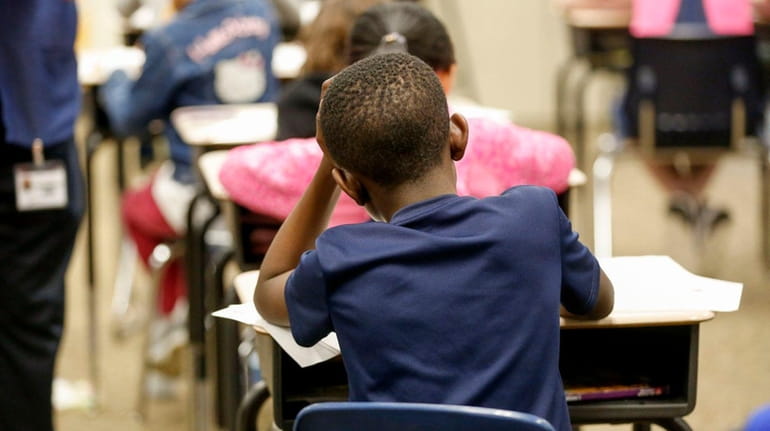It’s not called Common Core, and other FAQs about state tests

Fifth-graders at Longwood Middle School in Middle Island take the Common Core math test in 2017. Credit: Newsday / John Paraskevas
Don’t call it Common Core.
New York State’s academic guidelines are going by a new name these days, though much about the controversial tests remains the same.
There are some changes facing students and teachers across the state as they gear up for the English Language Arts and mathematics exams administered annually to students in grades 3-8.
Here’s what you need to know about what’s changed and what remains the same before testing begins.
What’s new this year?
Unlike in previous years, the upcoming exams will be given over only two test sessions — meaning students will take each test over two consecutive days instead of three. The state Board of Regents, which sets education policy, said the number of test periods was trimmed to “lessen testing fatigue for students and better enable them to demonstrate what they know.”
The tests also will have “substantially fewer questions,” Emily DeSantis, a spokeswoman for the state Education Department said in a statement — and they are getting a new name.
In 2017, after a two-year review, the Regents jettisoned the Common Core name. An amended set of more than 1,400 English and math standards were adopted and are referred to as the Next Generation Learning Standards.
The 2018 tests will still include questions based on the Common Core Learning Standards, but the state plans to fully implement Next Generation Learning Standards into the tests by spring 2021.
Reducing the number of days the tests are given and the duration of the exams was recommended in the December 2015 report of the Governor’s Common Core Task Force.
When are the tests?
School districts have chosen two consecutive days within a period of days designated by the Education Department to administer the tests, and the tests may be given on different days for different grades.
The paper version of the ELA exam will be administered on two consecutive days from April 11-13, with computer-based tests taken across two days from April 10-17.
Math tests taken on paper will be administered for two consecutive days from May 1-3, and computer-based tests on two days from May 1-8.
Check with your child’s school for information on test dates in grades 3-8 — and remember, all grades may not take the tests on the same two days.
What’s the same?
Tests will still be untimed and will include both multiple-choice and open-ended questions.
Schools are given the choice to give either paper or computer-based tests and the New York State Department of Education will continue to release 75 percent of questions following the test.
Accommodations will also be made for students with disabilities.
Educators across the state were involved in creating and reviewing questions for the test, and wrote many of them, too. In the future, the goal is to have state educators provide all test questions.
What are computer-based tests?
These tests will have the same questions as the paper versions, but students will select multiple-choice questions on a computer and type their responses instead of writing by hand.
Districts can choose whether to administer computer-based tests. On Long Island, 46 districts are giving computer-based tests for the ELA exam and 37 for math, according the state Education Department.
Statewide, three to five times as many students in grades 3-8 are expected to take computer-based tests this year compared with spring 2017.
How will the 2018 results be used?
Results will help chart the progress that schools, districts and the state are making toward state learning standards. Results cannot be used to make promotion or placement decisions regarding students or to evaluate teachers.
When will I get my child’s results?
Districts will receive student results over the summer. Statewide results are expected to be ready in mid-September.
What is the controversy over the exams?
Criticism of the exams has been broad and wide-ranging. Some educators and parents thought the test questions were not appropriate to children’s developmental level, and there was concern about linking teachers’ performance evaluations to students’ test scores. Parents also worried about the stress the tests put on their children and how test-prep time would affect other subjects and pursuits.
Is the opt-out movement expected to continue?
Tens of thousands of Long Island students have boycotted the Common Core tests in each of the past three years. The movement had begun in the spring 2012 test season.
Of the districts that responded to a 2017 Newsday survey, more than 97,000 students — or 51.2 percent of the 116 districts that responded — opted out of the ELA exam in 2017. On last year’s math exam, 90,217 students — or 53.6 percent of those in responding districts — opted out.
Those figures were relatively unchanged compared with the percentage who refused in 2016.
It’s hard to predict how many students will refuse the tests this year, said Jeanette Deutermann, a Bellmore parent of two and founder of the Long Island Opt Out network, but the movement has prompted a heightened level of engagement and awareness among parents.
“It is really a matter of every single child who does not have to sit for that assessment and every classroom that can be focused away from the test is a win whether the numbers go up or down,” she said.
— With Joie Tyrrell
